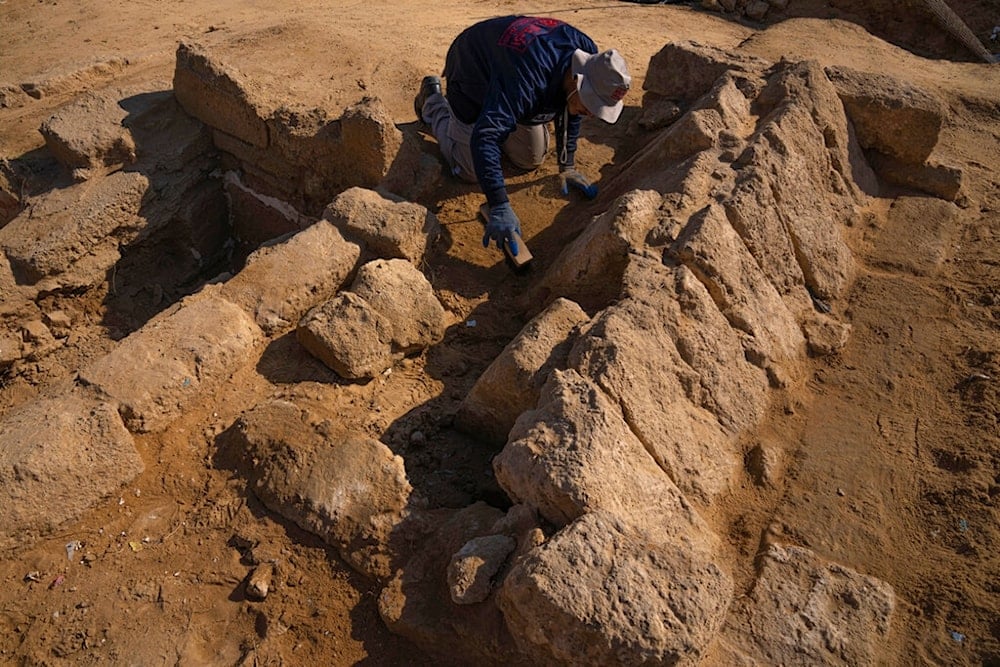Paris exhibition showcases 5,000 years of Gaza history, rare artifacts
The Paris exhibition, Saved Treasures of Gaza, unveils 5,000 years of Gaza’s history, displaying artifacts preserved from the war and highlighting its cultural legacy.
-

A member of a Palestinian excavation team works in a newly discovered Roman era cemetery in the Gaza Strip, Sunday, December 11, 2022 (AP)
A landmark exhibition in Paris is drawing large crowds this summer as it showcases more than 5,000 years of Gaza’s cultural and archaeological heritage, a legacy often overshadowed by the modern-day tragedy of war and starvation.
Saved Treasures of Gaza, currently on display at the Institut du Monde Arabe, features over 100 rare artifacts, from statuettes and oil lamps to imported marble, ancient inscriptions, and an expansive Byzantine mosaic. The collection tells the story of Gaza as a vibrant crossroads of cultures since Neolithic times, shaped by Philistines, Assyrians, Romans, Byzantines, Persians, and Mamluks.
“For thousands of years, Gaza was a hub of trade, learning, and celebration,” said lead curator Élodie Bouffard. “Our aim is to restore the humanity of Gaza and make its long history visible again, rather than reduce it to a zone defined only by tragedy.”
The artifacts have been held in storage in Switzerland for 17 years, following a 2007 exhibition in Geneva. Political instability and conflict prevented their return, a circumstance Bouffard said “saved them” from destruction in the current Israeli genocide, though it also kept them “hidden from public understanding.”
Aphrodite awaiting return home
One highlight is a small marble statue of a goddess, possibly Aphrodite or Hecate, dating back to the Roman or Hellenic era. The piece vanished in the early 5th century, possibly thrown into the sea, before being recovered by a fisherman off Blakhiya, a neighbourhood now destroyed, and passed to a Palestinian collector. “She has appeared and disappeared many times in history,” Bouffard said. “She is still waiting to return to where she was created.”
The exhibition also documents Gaza’s archaeological sites damaged or destroyed since 2023, including mosques, churches, archives, and the ancient Anthedon harbour, the territory’s first known seaport. Bouffard argued that while human lives must always take priority over heritage, understanding Gaza’s deep history could offer perspective and hope.
Jack Lang, president of the Institut du Monde Arabe and former French culture minister, said the show aims to “restore some hope in the future of Gaza,” adding, “Nothing is worse than abandonment and forgetting.”
Gaza's artifacts travel the world
Back in October, a Geneva exhibition hosted archaeological artifacts from the Gaza Strip as the enclave sought to continue safeguarding its heritage.
The Patrimony in Peril exhibition at the Museum of Art and History displayed 44 items discovered in Gaza, including amphoras, statuettes, vases, oil lamps, and figurines.
"It's a part of Gaza's soul. Its identity, even," Beatrice Blandin, the exhibition's curator, told AFP, stressing that heritage preserves the history of the land and its people.
The 44 treasures on display are part of a much bigger, 530-piece collection of objects from Gaza that have been stored for preservation in Geneva since 2007, unable to return to their home.
In this context, Geneva city councilor Alfonso Gomez slammed the intentional suppression and erasure of culture, saying, "The forces of obscurantism understand that cultural property is what is at stake for civilization, because they have never stopped wanting to destroy this heritage."
'Israel' continues wiping out Palestinian identity
Since the Israeli regime's genocidal war in Gaza began, cultural sites in the Palestinian territory have suffered significant damage, according to the United Nations' cultural organization.
As of May 27, 2025, UNESCO has verified damage to 110 sites since 7 October 2023: 13 religious sites, 77 buildings of historical and/or artistic interest, 3 depositories of movable cultural property, 9 monuments, 1 museum, and 7 archeological sites.
Among the most significant is the Saint Hilarion complex, a 4th-century monastery located in Gaza, which has been placed on UNESCO's endangered sites list due to "Israel's" ongoing onslaught in the Strip, the organization said.
The site, which is considered one of the oldest monasteries in the Middle East, was put on the list due to "imminent threats" highlighted by the Palestinian authorities.
"It's the only recourse to protect the site from destruction in the current context," UNESCO World Heritage Centre Director Lazare Eloundou Assomo said to AFP, referring to the Israeli occupation's war on Gaza.

 4 Min Read
4 Min Read











